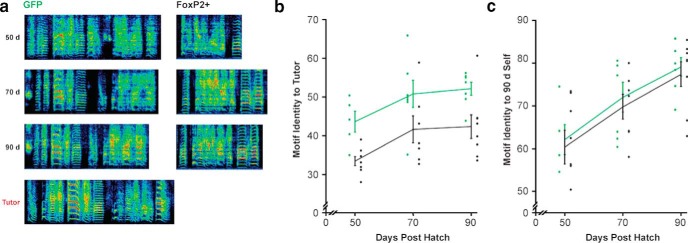Figure 3.
FoxP2 overexpression leads to imitation deficits that emerge early despite similar developmental trajectories. a, Spectrograms depict representative motifs of two pupils (GFP control and FoxP2+) at 3 stages of sensorimotor learning (50, 70, and 90 d) and that of their shared tutor. b, Motif identity scores indicate the similarity of a pupil's motif to that of its tutor. Scores are plotted for three ages of each control GFP (green) and FoxP2+ (black) pupil. The latter group had lower scores at 50 d (p = 0.0028, n = 5GFP/8FoxP2+, unpaired one-tailed bootstrap), 70 d (p = 0.0398, n = 7GFP/7FoxP2+, unpaired one-tailed bootstrap), and 90 d (p = 0.0082, n = 8GFP/8FoxP2+, unpaired one-tailed bootstrap). The motifs of both groups of pupils became increasingly similar to that of the tutor between 50 and 70 d (GFP: p = 0.0471, n = 5; FoxP2+: p = 0.0166, n = 7; paired one-tailed bootstrap), but not between 70 and 90 d (GFP, p = 0.2772, n = 7; FoxP2+: p = 0.1786, n = 7; paired one-tailed bootstrap). c, Motif identity scores indicate the similarity of a pupil's motif to its own adult version. Scores are plotted for three ages of each control GFP (green) and FoxP2+ (black) pupil. Both groups followed similar developmental trajectories manifested by increases in similarity to adult song between 50 and 70 d (GFP: p = 0.0204, n = 5; FoxP2+: p = 0.0214, n = 8; paired one-tailed bootstrap), and between 70 and 90 d (GFP: p = 0.0004, n = 7; FoxP2+: p = 0.0214, n = 7; paired one-tailed bootstrap) and no difference between groups at the 50, 70, or 90 d time points (p = 0.7517, 0.6381, 0.6366, respectively; unpaired one-tailed bootstrap).

